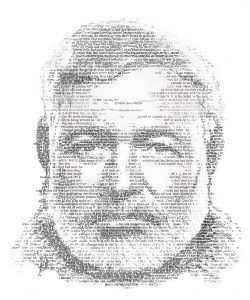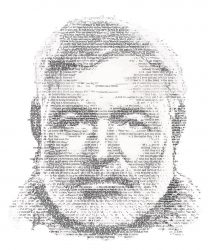Recognizing The Gentleman From America
My Thoughts Induced by "Hemingway"
 I RECALL Professor Charles Nilon, teaching a class in modern novels at Boulder, identified Ernest Hemingway as “an American gentleman.” The memory surfaced as I watched the first episode of the Ken Burns documentary on PBS. Like a British noble, Hemingway toured the colonies, hunted trophy animals, behaved well in military combat, was a sportsman and manly drinker and was covered royally by the press. His life spanned the age of magazine photography, and many of those artful pictures illustrate the Burns production. Nilon was the first Black faculty member at the University of Colorado, a status that was celebrated when he retired at Boulder five years ago, but back then in the sixties it was barely publicized. In retrospect I added to his definition of American gentleman class-conscious discriminating racist.
I RECALL Professor Charles Nilon, teaching a class in modern novels at Boulder, identified Ernest Hemingway as “an American gentleman.” The memory surfaced as I watched the first episode of the Ken Burns documentary on PBS. Like a British noble, Hemingway toured the colonies, hunted trophy animals, behaved well in military combat, was a sportsman and manly drinker and was covered royally by the press. His life spanned the age of magazine photography, and many of those artful pictures illustrate the Burns production. Nilon was the first Black faculty member at the University of Colorado, a status that was celebrated when he retired at Boulder five years ago, but back then in the sixties it was barely publicized. In retrospect I added to his definition of American gentleman class-conscious discriminating racist.
A generation later my daughter Maia was a student of James Alan McPherson of the Iowa Writers’ Workshop. She too watched some of the Burns documentary and recalled a question by McPherson, a follower of Ralph Ellison (“Invisible Man”): “Was Hemingway authentic?” The class response was “No.” She emailed me the other day:
We really loved McPherson. Many times, he took us from the house on top of the hill to his own home to have Workshop. It was there that we discussed this essay on Hemingway and the woman’s voice. But it went beyond that because it had to do with authenticity and the first person voice. Taking on the voice of someone from a different culture or class that you may not really authentically know and portraying their lived experience is a big deal. That then bled into what is true non-fiction and what is “creative” nonfiction.
Hemingway’s most creative nonfiction was his own persona, and this was the tragic theme of the second and third episodes of the Burns documentary. Tragic, because he was a writer with a new style (for which at the end of his life he received the Nobel prize for literature.)
Maia attached an interview in which McPherson said:
The social problem is this: you’ve got a class system, but the fact of race obscures that. It is not a democracy, it’s a class-bound system. We’re talking about taste, we’re talking about money, and if you’ve got money you can buy class. You can buy it.
Hemingway bought class and literary contacts at the outset of his career with his first two wives’ money. Hadley and Pauline Pfeiffer were from wealthy families. By the time he was famous as America’s greatest fiction writer, he had his own money and two more wives, Martha Gellhorn and Mary Welsh, both magazine journalists.
He also was an alcoholic. Burns treads carefully on this, but the pathos of Hemingway as a sarcastic snobbish drunk was documented long ago in the oft-forgotten profile of his visit along with Mary to New York in the spring of 1950. Lillian Ross, in her almost stenographic account in the New Yorker, has him speaking an invented telegraphic idiom without articles. He presents his judgments in sports metaphors, as if he had been a baseball pitcher or a prize fighter. And he drinks constantly.
He repeatedly interrupts his soliloquies with the most memorable quote coming out of the article: “How do you like it now, gentlemen?” The cryptic line is not explained, but I suppose it is something a painter would say as he reworked a portrait to suit the people who commissioned it. Or: a writer revising a text to suit the editors and critics (who were a powerful and unified group of men in the city at the time). Or, more directly relevant, a celebrity giving self-serving quotes to a magazine writer.
The Burns documentary’s literary sensitivity saves it from being just another romance of Hemingway. I loved the praise of “For Whom The Bell Tolls” by the late Sen. John McCain (Take that, machismo Trumpists!) And I was gratified by the concluding quote from “The Snows of Kilimanjaro.” The dying writer is, or thinks he is, in a rising rescue plane “and there, ahead, all he could see, as wide as all the world, great, high, and unbelievably white in the sun, was the square top of Kilimanjaro. And then he knew that that was where he was going.”
The prologue says the frozen carcass of a leopard is near the 19,710-foot summit, and, “No one has explained what the leopard was seeking at that altitude.” Similarly, the viejo in “The Old Man And The Sea” went “out too far” in the sea seeking what he eventually would lose.
I don’t know if the Burns documentary will revive interest in Hemingway. His works are no longer popular. The last time I attended the Telluride Film Festival, in 2013, I discussed J. C. Chandor’s “All Is Lost” with some young people perplexed by the ending. I said I believed it was like the ending of “The Snows of Kilimanjaro.” Nobody had read it.
And I suspect nobody of the new generations will have much sympathy for the delusional, mean, alcoholic writer who blew his brains out in his home in Sun Valley, Idaho, at first light on July 2, 1961. I don’t know of any significant material memorials to Ernest Hemingway — except for a simple placard that bears his name on the bank of Trail Creek near his final home. It quoted a eulogy he once wrote for a friend there:
Best of all he loved the fall, the leaves yellow on the cotton woods. Leaves floating on the streams. The high blue windless skies. Now he will be part of them forever.
But there is a word memorial: compassionate interpretation of remarkable and important life. Namely, he suffered from what now is called brain trauma, due to multiple skull fractures. One symptom is lack of impulse restraint, including the impulse to drink.
A psychiatric evaluation of Hemingway would require — and probably did — many professionals, but as a reader of his stories I see evidence of another newly defined disorder: sleep paralysis. It is described by Shelley R. Adler, professor of medical anthropology, in her 2011 book, “Sleep Paralysis.” Her simplest description of the malady is “a stage in which the body is asleep but the mind is not.”
It has been diagnosed in the new sleep laboratories that test for sleep apnea, but it has been documented since medieval times. And she makes the case that for those who believe the experience is a satanic visitation it can be mysteriously fatal — as presumably it has been for Hmong immigrants in the United States who die with no other indication of the cause of death. The cover of Adler’s book is the 1781 painting by Henry Fuseli showing a supine woman terrified on her sleeping couch by an ogre seated on her chest as a ghostly horse (night mare) watches.
Her further description includes this:
The victim’s impression of wakefulness, inability to move or speak, realistic perception of the immediate environment, intense fear and anxiety, lying in a supine position, feeling pressure on the chest, difficulty breathing, and awareness of a ‘presence’ that is often seen or heard.
Hemingway’s characters often fear sleep, as he did. And though he did not write personally of his own problems, his leading principal was to write truly from experience. The ending of Kilimanjaro documents sleep paralysis as an entry to death.
It had moved up on him now, but it had no shape any more. It simply occupied space.
Tell it to go away.”
It did not go away but moved a little closer.
“You’ve got a hell of a breath,” he told it. “You stinking bastard.”
It moved up closer to him still and now he could not speak to it, and when it saw he could not speak it came a little closer, and now he tried to send it away without speaking, but it moved in on him so its weight was all upon his chest, and while it crouched there and he could not move or speak, he heard the woman say, “Bwana is asleep now. Take the cot up very gently and carry it into the tent.”
He could not speak to tell her to make it go away and it crouched now, heavier, so he could not breathe.



This is indeed a compassionate interpretation. I appreciate it; it gives him greater dimension and more humanity—and shows yours. Thanks.
Gussie
Hi Larry,
What a moving essay. It brings me right back to Mayme and Harry’s house. I’m on the living room floor reading “the Old Man and the Sea”. I was transported into the small boat, I lived each minute, I forgot where I was. When I finished the book, I sort of woke up and looked around wondering where I was. I haven’t had that experience again in all these years.
Mom also loved Hemingway. She had most of his books, but not “The Old Man and the Sea”. I have her Hemingway books.
I picked up the book a year or so later, craving for the experience again, but it was a one time experience being real.
Keep up your great work!